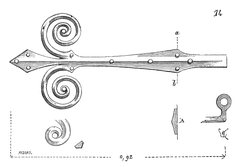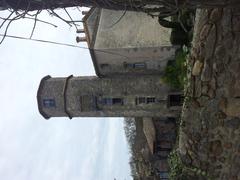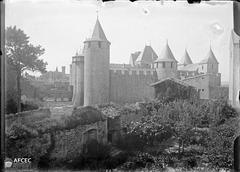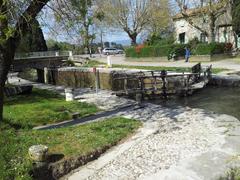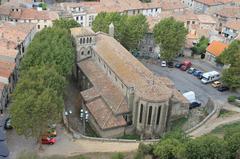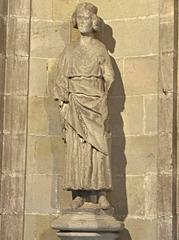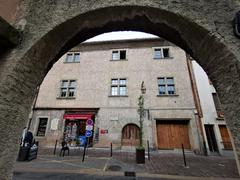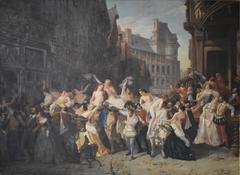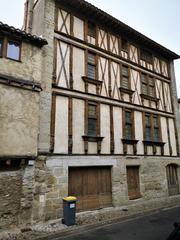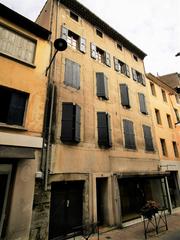Bains-Douches De Carcassonne: Visiting Hours, Tickets, and Historical Significance
Date: 14/06/2025
Introduction
Tucked just beyond the iconic medieval ramparts of Carcassonne, the Bains-Douches de Carcassonne offer an essential and often overlooked window into the city’s evolution. Originally constructed at the turn of the 20th century, these public bathhouses reflect a period of civic transformation, urban modernization, and the growing importance of public health in French society. Their enduring presence—marked by striking Art Nouveau and Art Deco features—complements Carcassonne’s renowned medieval identity, inviting visitors to explore a different layer of the city’s heritage.
This detailed guide explores the Bains-Douches’ origins, architectural and social evolution, preservation status, and practical visitor information—including visiting hours, tickets, accessibility, and nearby attractions. Whether you are a history buff, architecture enthusiast, or a traveler seeking authentic experiences, this comprehensive resource will help you discover one of Carcassonne’s most unique and meaningful sites.
For planning and additional insights, consult the official Carcassonne tourism website, History Hit, and FranceGuide.info.
Table of Contents
- Introduction
- Historical Origins and Early Development
- Architecture and Social Function
- Urban Health Initiatives and Community Impact
- 20th-Century Changes and Contemporary Revival
- Preservation and Adaptive Reuse
- Practical Visitor Information
- Cultural Etiquette and Local Customs
- Nearby Attractions
- Safety, Sustainability, and Community Engagement
- FAQ
- Visuals and Virtual Tours
- Contact and Further Information
- Summary and Call to Action
- References
Historical Origins and Early Development
Public bathhouses have long played a role in Carcassonne’s urban history, with roots in Roman thermae that served both hygiene and social functions (History Hit). Through centuries of change, the communal spirit of bathing endured, but it was the late 19th and early 20th centuries—amid rising industrialization and increased urban populations—when dedicated bains-douches appeared across France.
Carcassonne’s first municipal bathhouses were established to address a pressing need: providing access to hygiene for working-class residents of neighborhoods like Bastide Saint-Louis who often lacked private bathing facilities (Wikidata). These facilities became symbols of modernization and civic commitment.
Architecture and Social Function
The Bains-Douches de Carcassonne exemplify the Art Nouveau and Art Deco styles popular at the time of their construction, recognizable through decorative tilework, wrought-iron details, and purposeful interior layouts. Facilities featured gender-segregated bathing areas, individual cubicles, communal showers, and laundry spaces, balancing efficiency, privacy, and community.
More than functional infrastructure, these sites were social meeting points. For many, especially women and children, the bathhouses provided rare public venues for interaction and support, helping foster social cohesion across Carcassonne’s diverse neighborhoods (Britannica).
Urban Health Initiatives and Community Impact
The emergence of bains-douches in Carcassonne was closely tied to public health campaigns aimed at combatting infectious diseases and promoting cleanliness in urban environments. Their introduction marked a turning point in shifting social norms around hygiene and well-being, reinforcing the city’s reputation for civic progressiveness (FranceGuide.info).
Bathhouses also played a vital role in integrating newcomers and marginalized populations, offering affordable services and a sense of belonging in rapidly changing urban landscapes.
20th-Century Changes and Contemporary Revival
With the spread of indoor plumbing and private bathrooms by the mid-20th century, the daily reliance on public bathhouses waned. Nevertheless, the Bains-Douches continued to serve vulnerable groups for decades, until many were either closed or repurposed for new uses (Wikidata).
In recent years, a revival has taken place: preservation efforts have restored the architectural fabric of these sites, and adaptive reuse has turned them into cultural venues, wellness centers, and community spaces. This transformation ensures that the Bains-Douches remain relevant as living monuments, bridging Carcassonne’s past and present (FranceGuide.info).
Preservation and Adaptive Reuse
The Bains-Douches De Carcassonne benefit from local conservation policies that safeguard their structure and character (Monuments de France). Restoration works have focused on authentic materials and craftsmanship, retaining original floor plans, tiling, and signage. Today, the site is used for art exhibitions, workshops, and educational programs, reinforcing its role as a center for community life (Occitanie Travel).
Practical Visitor Information
Visiting Hours
- General Schedule: Open Tuesday to Sunday, 10:00 AM to 6:00 PM. Hours may fluctuate seasonally or during special events.
- Special Openings: Extended hours or additional access during European Heritage Days and city festivals.
- Confirmation: Always verify current visiting hours on the official Carcassonne tourism website.
Tickets and Fees
- Admission: Free for most exhibitions and community events. Some special programs or guided tours may require a modest fee.
- Booking: Advance booking is rarely needed for general admission but recommended for guided tours or workshops (Carcassonne Tourisme).
Accessibility
- Facilities: Step-free entrances and adapted restrooms. Some historic features may limit access to certain areas; staff can advise on accessible routes.
- Assistance: Inquire in advance for specific accessibility needs.
Guided Tours and Events
- Guided Tours: Available periodically, particularly during festivals and heritage events—book through the tourist office or online.
- Events: Regularly hosts art exhibitions, cultural workshops, and community gatherings.
Travel Tips
- Visit in spring or autumn for fewer crowds and pleasant weather.
- Combine your trip with nearby attractions in the Bastide Saint-Louis and along the Canal du Midi.
- Wear comfortable shoes; historic tile floors can be slippery.
Cultural Etiquette and Local Customs
- Maintain a quiet, respectful demeanor, especially during exhibitions or workshops.
- Discreet photography is generally permitted—observe posted guidelines.
- Engage with local artists and residents during community events to enrich your experience.
Nearby Attractions
- Bastide Saint-Louis: Explore the lively market quarter and its shops (Go Languedoc).
- Musée des Beaux-Arts: Discover fine art from the 17th century onward (Just Gone Wandering).
- Canal du Midi: Enjoy scenic walks or boat tours along this UNESCO-listed waterway (France Adventurer).
- Local Markets: Experience Carcassonne’s regional produce and vibrant street life (Carcassonne Agenda).
Safety, Sustainability, and Community Engagement
Carcassonne is a safe and welcoming city. The Bains-Douches are located in a well-trafficked area, with staff present during opening hours. Support local artisans and participate in workshops to help sustain the site’s community focus and cultural programming.
Frequently Asked Questions (FAQ)
Q: What are the Bains-Douches De Carcassonne visiting hours?
A: Generally Tuesday to Sunday, 10:00 AM–6:00 PM. Check here for current schedules.
Q: Are tickets required for entry?
A: Admission is usually free. Some special events or tours may require a ticket.
Q: Is the site accessible to those with limited mobility?
A: Most of the venue is accessible; staff can assist with any challenges.
Q: Are guided tours available?
A: Yes, especially during cultural events and heritage days. Booking in advance is advised for tours.
Q: Can I take photographs inside?
A: Usually yes, but follow posted signs, particularly during exhibitions.
Visuals and Virtual Tours
Explore a virtual tour of the Bains-Douches before your visit.
Contact and Further Information
Find up-to-date details, schedules, and booking options on the official Carcassonne tourism website. Multilingual assistance and brochures are available at the local tourist office. For curated tours and additional resources, download the Audiala app.
Summary and Call to Action
The Bains-Douches de Carcassonne present a vital chapter of the city’s urban and social history, illustrating the transformation from medieval stronghold to modern civic community. Their preservation and adaptive reuse as cultural centers ensure their continued relevance, offering insight into Carcassonne’s commitment to social progress and architectural heritage.
Visitors are encouraged to explore the Bains-Douches alongside Carcassonne’s famed medieval attractions for a richer, more nuanced understanding of the city’s past and present. For the latest information on visiting hours, special events, and exhibitions, refer to the official Carcassonne tourism agenda. Support sustainable tourism and local initiatives to help preserve this unique heritage for future generations. Download the Audiala app for guided tours and real-time tips, and follow Carcassonne’s heritage updates on social media.
References
- Discovering the Bains-Douches de Carcassonne: History, Visitor Info & Cultural Significance, 2025, (History Hit)
- Visiting Carcassonne’s Historic Public Bathhouses: Hours, Tickets, and Cultural Insights, 2025, (Britannica)
- Discovering Bains-Douches De Carcassonne: History, Preservation, Visiting Hours, and Visitor Tips, 2025, (FranceGuide.info)
- Bains-Douches De Carcassonne Visiting Hours, Tickets, and Visitor Guide to Carcassonne Historical Sites, 2025, (Travel France Blog)
- UNESCO World Heritage Listing for Carcassonne, 2025, (History Hit)
- Official Carcassonne Tourism Website, 2025, (Carcassonne Tourisme)
- Occitanie Travel Guide, 2025, (Occitanie Travel)
Thank you for exploring the Bains-Douches de Carcassonne. Begin your discovery today and experience the living history of this remarkable city.

